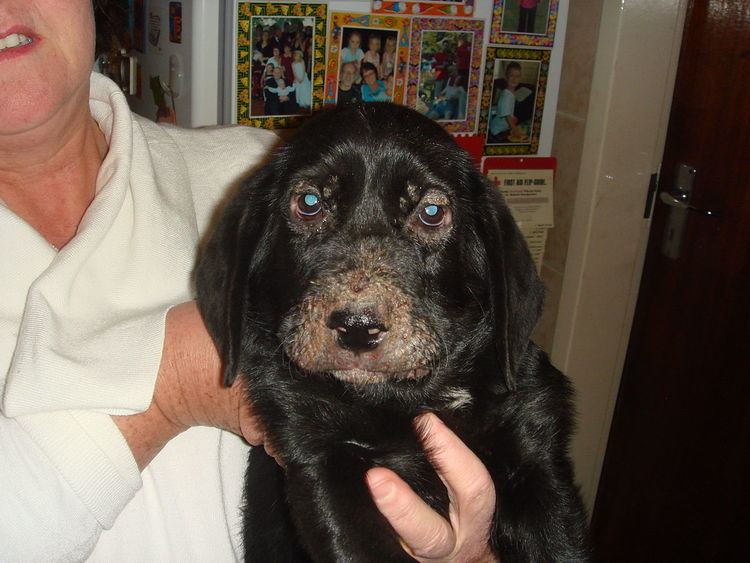 | ||
Juvenile cellulitis, also known as puppy strangles or juvenile pyoderma, is a disease of dogs. Symptoms include dermatitis, lethargy, depression and lameness. When puppies are first presented with what appears to be staphylococcal pyoderma, juvenile cellulitis, a relatively rare condition, may not be considered.
Contents
Symptoms
The first symptom is a sudden onset of swelling of the face, which develops within two days into papules and pustues on the lips, nose, and around the eyes. These pustules release a purulent discharge, causing a crust to form on the skin. There is also lymphadenopathy (swelling of lymph nodes) in the main lymph nodes of the head. The feet, body, prepuce or perianal area may be affected. Pustular otitis externa can occur, with the pinnae (ear flaps) becoming thickened by edema. Affected areas are painful but not itchy. Approximately half of affected puppies have lethargy and depression. Less common symptoms include pyrexia, anorexia, and joint pain, caused by sterile suppurative arthritis.
Causes
The cause of juvenile cellulitis is unknown. Cytologic examination of aspirates of affected lymph nodes, pustules, abscesses, and joint fluid rarely reveal bacteria, and culture results of intact lesion are always negative for bacterial growth, suggesting a nonbacterial etiology.
Misdiagnosis
Puppies are first presented with what appears to be staphylococcal pyoderma. Definitive diagnosis requires cytologic and histopathologic evaluations. Cytologic examination of papulopustular lesions of juvenile cellulitis reveals pyogranulomatous inflammation with no microorganisms and carefully performed cultures are negative. Biopsies of early lesions reveal multiple discrete or confluent granulomas and pyogranulomas consisting of clusters of large epithelioid macrophages with variably sized cores of neutrophils. Cytological analysis of joint fluid often reveals sterile suppurative arthritis.
Treatment
The condition responds dramatically to corticosteroids, suggesting an immune dysfunction. Large doses of glucocorticoids are the treatment of choice. When the puppy's condition has resolved, prednisone is tapered off slowly over a period of weeks. Early and aggressive therapy is indicated, otherwise scarring may be severe. If cytological or clinical evidence of secondary bacterial infection exists, bactericidal antibiotics, such as cephalexin, cefadroxil, and amoxicillin clavulanate, should be prescribed.
